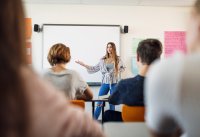4 Steps to Raise Students’ Learning Threshold
As students go through the steps of observing, participating, practicing, and performing, they take control of their own learning.
Your content has been saved!
Go to My Saved Content.When I’m trying to learn something, at first the content is difficult as I try to understand the vocabulary, acronyms, and any new ideas. As I start to recognize these terms and ideas, the study gets a bit easier and the pace picks up. As I practice and work through concepts and skills, I begin to feel comfortable. Through this process, my learning threshold has been raised and my capacity to learn has increased.
My job as an educator is to help students to raise their learning thresholds. From the student perspective, the learning process has four steps in which the teacher plays a vital role.
1. Observe (Comprehension)
2. Participate
3. Practice
4. Perform
Observe
In the “I do, we do, you do” framework, the “I do” demonstration helps students prepare to learn. I find that the more relevant the introduction, the more powerful the impression on the students’ minds will be. Please note that this introduction is not a warm-up sponge activity that you use while perhaps taking roll and getting the class started.
When I teach simple relations or equations, for example, I introduce them with a demonstration of speed. I show a segment from the first Back to the Future movie in which the professor explains to the Michael J. Fox character, Marty McFly, that in order for his machine to work, they have to reach 88 miles per hour.
I show the students that they’ll be re-creating this experiment with a car and a track. The goal is to reach a certain speed with their car (not 88 miles per hour, of course). I then model what they’ll be doing. I ask a student to roll a car to me. Then I roll it back faster. A third student times these trips.
I help students understand that the car went the same distance in less time because the speed changed. This is when I write the relation in words: “The greater the speed, the shorter the time.” We talk about miles per hour and the formula R=D/T (rate of speed = distance divided by time).
Participate
Because the students know what they’re going to be doing, they have a place to put this information in their brains. In the “we do” portion of the lesson, in which they do the experiment, I put the students in groups of four. In cooperative learning groups, each student needs to do something. They may select a recorder, a time keeper, an engineer, and a manager.
Then they set up their track, establish the goal time using the math they just learned, and try to make it work. To further cement the math in their memory, the groups trade record sheets and check each other’s data.
Practice
This is the “you do” section of the lesson. Students practice independently, using what they’ve learned to resolve other problems. Based on their experience, students are ready to see if they can explore by changing variables in the experiment. Students will discover the answers to these questions:
• How does changing the height or the length of the ramp change the speed?
• How can I predict the result based on the relationship?
Perform
When a student is prepared for a challenge, they have a positive feeling about being able to perform well for others. This is what happens on athletic fields, at art shows, in theatrical plays, and in concert halls—the brain releases endorphins, and it wants more. A presentation of learning could be a competition, a relay, a puzzle, a story, a dance, a piece of art, a cartoon, a demonstration, a dramatization, a song, a rap, a news report, a radio broadcast, or if absolutely necessary a quiz. The more realistic and relevant the evaluation methods are, the more memorable the lesson will be—and the ability to apply that new learning will increase.
When students are intent on observing, participating, practicing, and performing, they take control of their own learning. Students need to know these four steps of the process so they can replicate it any time they need to really learn something.
A responsive teacher simply helps students raise their learning threshold by creating a learning environment that captures their imagination and enthusiasm and prepares the student for the next level.
